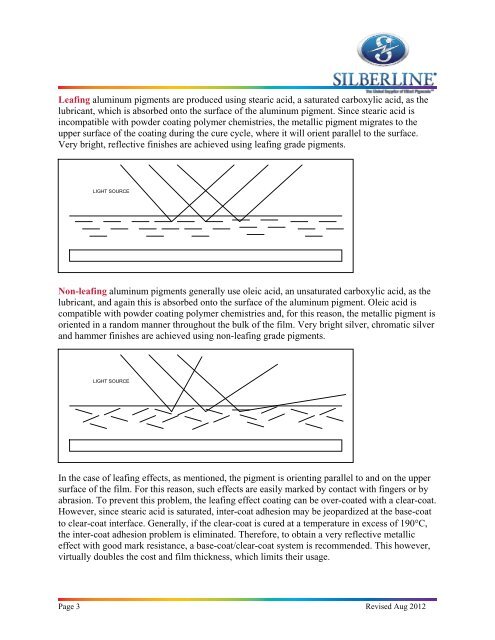Aluminum Pigments for Powder Coatings - Silberline Manufacturing ...
Aluminum Pigments for Powder Coatings - Silberline Manufacturing ...
Aluminum Pigments for Powder Coatings - Silberline Manufacturing ...
You also want an ePaper? Increase the reach of your titles
YUMPU automatically turns print PDFs into web optimized ePapers that Google loves.
Leafing aluminum pigments are produced using stearic acid, a saturated carboxylic acid, as the<br />
lubricant, which is absorbed onto the surface of the aluminum pigment. Since stearic acid is<br />
incompatible with powder coating polymer chemistries, the metallic pigment migrates to the<br />
upper surface of the coating during the cure cycle, where it will orient parallel to the surface.<br />
Very bright, reflective finishes are achieved using leafing grade pigments.<br />
LIGHT SOURCE<br />
Non-leafing aluminum pigments generally use oleic acid, an unsaturated carboxylic acid, as the<br />
lubricant, and again this is absorbed onto the surface of the aluminum pigment. Oleic acid is<br />
compatible with powder coating polymer chemistries and, <strong>for</strong> this reason, the metallic pigment is<br />
oriented in a random manner throughout the bulk of the film. Very bright silver, chromatic silver<br />
and hammer finishes are achieved using non-leafing grade pigments.<br />
LIGHT SOURCE<br />
In the case of leafing effects, as mentioned, the pigment is orienting parallel to and on the upper<br />
surface of the film. For this reason, such effects are easily marked by contact with fingers or by<br />
abrasion. To prevent this problem, the leafing effect coating can be over-coated with a clear-coat.<br />
However, since stearic acid is saturated, inter-coat adhesion may be jeopardized at the base-coat<br />
to clear-coat interface. Generally, if the clear-coat is cured at a temperature in excess of 190C,<br />
the inter-coat adhesion problem is eliminated. There<strong>for</strong>e, to obtain a very reflective metallic<br />
effect with good mark resistance, a base-coat/clear-coat system is recommended. This however,<br />
virtually doubles the cost and film thickness, which limits their usage.<br />
Page 3 Revised Aug 2012


